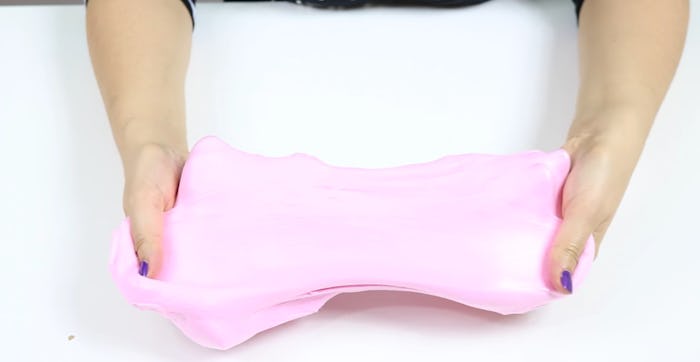Life

How To Make Safe, Homemade Slime
There are a lot of DIY, at-home science experiments that can be done with kids that aren't just educational, but also a fun. Although few people would argue that cooking and baking with little ones is easy, it is the easiest way to demonstrate science. Making homemade slime, for example, is a classic experiment that excites kids. That being said, science experiments can sometimes be a little bit dangerous for kids who don't necessarily know all of the requisite safety precautions that need to be taken, so it's important to know how to make safe homemade slime, so your science lesson doesn't end in disaster.
Traditionally (can you call a homemade slime recipe traditional?), homemade slime is made by mixing Borax with liquid glue, food coloring, and water. However, after an 11-year-old in Massachusetts suffered third degree burns from her homemade slime, parents have begun to question its safety as well as seek out recipes that might be a bit safer. Doctors told the Massachusetts family that the burns were due to the addition of Borax, according to People. Many doctors, however, such as Dr. Vanessa Stoloff, a family practitioner at the University of Pennsylvania, who told Parents that there shouldn't be enough Borax added to slime recipes to get absorbed through the skin, say that the aforementioned traditional recipe is safe as long as kids aren't ingesting the slime they make. There are stories beyond the most recent one, however, of kids burning themselves after handling Borax, especially if they have sensitive skin.
The good news is there are also many ways to make homemade slime that leaves the Borax on the shelf in favor of, perhaps, more benign ingredients like cornstarch. So even if your kiddo has sensitive skin, they don't have to miss out on all of the slime-making fun. Here are just a few ways to make safe slime from the comfort of your own kitchen — no lab required.
1Cornstarch Slime
This slime is all the rage on Instagram. It starts with a cornstarch base to which you add glue, shampoo, detergent, lotion, and food coloring. The resulting "slime" is more like a mix between slime, salt dough, and kinetic sand, meaning it holds its shape and is more pliable than your typical homemade slime.
2Nutella Slime
Yep, slime made from chocolate hazelnut spread that you can eat. This one is more like dessert than a science project, but it couldn't be easier. Two ingredients, chocolate hazelnut spread and marshmallows, melted and combined, turn into an edible slime that the creator said, "tastes like Tootsie Rolls."
3Laundry Detergent Slime
Perhaps the easiest slime recipe, this slime is made with pink glitter glue (or another that you'd like) and laundry detergent. Add the laundry detergent a little bit at a time to transform your glue into slime.
4Dish Soap Slime
This slime recipe uses dish soap instead of Borax or detergent as well as saline solution to help the mixture turn into slime. Using clear glue means you can add glitter or other decorations, because they'll show up well and won't be masked by the opacity of other glues.
5Salt Slime
If you have glue, water, and salt, you can make this slime. If your clear glue contains PVA, a rubbery polymer, then you're good to go. Mix-ins like glitter are very popular when using clear glue.
6Powdered Fiber Slime
This slime is edible thanks to the addition of powdered fiber instead of the glue or soaps. It stretches a bit, but perhaps not as much as one made with glue and soap. If your kiddo is going to take a taste, make sure they don't eat too much of it, because it's basically all fiber.
7Kool-Aid Slime
This slime (or goo) doesn't stretch out as much as the others, but is edible and actually combines powdered fiber with Kool-Aid. Edible slimes are great for your little ones because, while you don't want them to overdo it on either sugar or powdered fiber, let's face it: there was a pretty good chance they were going to put it in their mouths anyway.